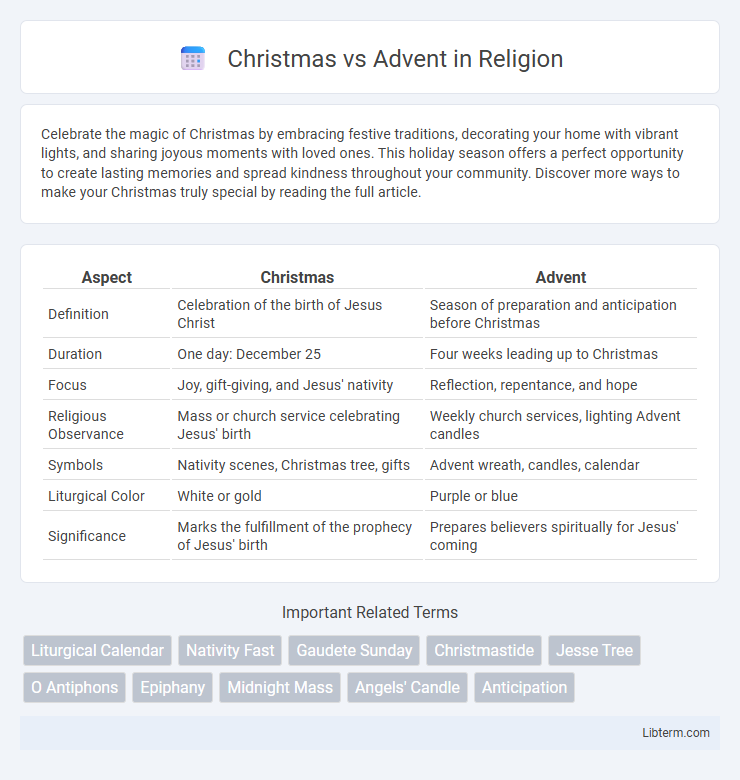Celebrate the magic of Christmas by embracing festive traditions, decorating your home with vibrant lights, and sharing joyous moments with loved ones. This holiday season offers a perfect opportunity to create lasting memories and spread kindness throughout your community. Discover more ways to make your Christmas truly special by reading the full article.
Table of Comparison
| Aspect | Christmas | Advent |
|---|---|---|
| Definition | Celebration of the birth of Jesus Christ | Season of preparation and anticipation before Christmas |
| Duration | One day: December 25 | Four weeks leading up to Christmas |
| Focus | Joy, gift-giving, and Jesus' nativity | Reflection, repentance, and hope |
| Religious Observance | Mass or church service celebrating Jesus' birth | Weekly church services, lighting Advent candles |
| Symbols | Nativity scenes, Christmas tree, gifts | Advent wreath, candles, calendar |
| Liturgical Color | White or gold | Purple or blue |
| Significance | Marks the fulfillment of the prophecy of Jesus' birth | Prepares believers spiritually for Jesus' coming |
Understanding Christmas and Advent: Key Differences
Christmas is the celebration of the birth of Jesus Christ on December 25th, marking a specific event in Christian tradition. Advent, lasting approximately four weeks before Christmas, is a liturgical season dedicated to preparation, reflection, and anticipation of Christ's coming. While Christmas centers on joy and festivity, Advent emphasizes hope and spiritual readiness.
Historical Origins of Christmas and Advent
Christmas originated as a Christian festival celebrating the birth of Jesus Christ, with its date set on December 25th in the 4th century to coincide with Roman pagan winter solstice celebrations. Advent, established in the early Middle Ages, is a liturgical season of preparation and anticipation lasting four weeks before Christmas, derived from the Latin word "adventus" meaning "coming." Both Christmas and Advent have roots deeply embedded in Christian traditions, yet Advent serves as a period leading up to the joyous celebration of Christmas.
Theological Significance: Christmas vs Advent
Christmas celebrates the incarnation of Jesus Christ, emphasizing God's ultimate gift of salvation and the fulfillment of Old Testament prophecies. Advent marks a season of anticipation and preparation, reflecting on the coming of Christ both historically at Bethlehem and spiritually in believers' hearts. Theologically, Advent focuses on hope and repentance, while Christmas centers on joy and the manifestation of God's redemptive plan through Jesus.
Symbols and Traditions of Christmas
Christmas is celebrated with symbols such as the Christmas tree, wreaths, nativity scenes, and lights that represent joy and the birth of Jesus Christ. Traditions include exchanging gifts, singing carols, decorating homes, and sharing festive meals with family and friends. These practices emphasize themes of generosity, community, and religious significance connected to Christmas Day on December 25th.
Symbols and Traditions of Advent
Advent is symbolized by the Advent wreath, which features four candles representing hope, peace, joy, and love, traditionally lit one on each Sunday leading up to Christmas. Other common Advent traditions include the Advent calendar, used to count down the days until Christmas with daily small gifts or scripture readings, and the use of purple and pink liturgical colors in decorations, signifying penitence and celebration. These symbols and rituals emphasize preparation and anticipation for the birth of Christ, distinguishing Advent's reflective nature from the celebratory focus of Christmas.
Liturgical Practices During Advent and Christmas
Liturgical practices during Advent center on anticipation and preparation, featuring the lighting of the Advent wreath's candles and the proclamation of Scripture focused on hope, peace, joy, and love. Christmas liturgy shifts to celebrating the Nativity of Christ with the Midnight Mass, festive hymns like "O Holy Night," and the reading of Luke's Nativity narrative, emphasizing the incarnation and joy of Christ's birth. Both seasons include distinct colors--violet or blue for Advent symbolizing penitence and expectation, and white or gold for Christmas representing purity and celebration.
How Cultures Celebrate Christmas and Advent
Christmas is celebrated worldwide with diverse traditions such as decorating Christmas trees, exchanging gifts, and attending festive church services, while Advent is observed primarily in Christian communities through lighting Advent candles and daily scripture readings to prepare for Christmas. In Western cultures, Christmas festivities often include Santa Claus, festive meals, and caroling, whereas Advent practices emphasize reflection, prayer, and anticipation of Christ's birth. Many European countries blend both celebrations, using Advent wreaths and calendars leading up to Christmas Day marked by family gatherings and religious ceremonies.
Emotional and Spiritual Themes of Each Season
Christmas evokes profound joy and gratitude as it celebrates the birth of Jesus Christ, symbolizing hope, love, and divine light entering the world. Advent, marking the four weeks leading to Christmas, emphasizes anticipation, reflection, and spiritual preparation, inviting believers to cultivate patience, faith, and inner renewal. Both seasons intertwine emotional warmth and deep spirituality, guiding Christians through a journey of expectation and celebration.
Modern Interpretations of Advent and Christmas
Modern interpretations of Advent emphasize personal reflection, preparation, and mindfulness, often integrating contemporary practices like meditation and community service. Christmas celebrations today focus on inclusive cultural expressions, blending traditional religious elements with secular festivities such as gift-giving, festive decorations, and family gatherings. Both Advent and Christmas have evolved to accommodate diverse beliefs while maintaining their core themes of hope and joy.
Integrating Advent and Christmas in Holiday Preparation
Integrating Advent and Christmas in holiday preparation involves combining the anticipation and reflection of the Advent season with the celebration of Christmas Day. Families can enhance their festive traditions by using Advent calendars, wreaths, and daily devotionals to build a meaningful countdown that culminates in Christmas festivities. This approach fosters spiritual mindfulness and a deeper appreciation of the holiday's religious significance while creating a cohesive and enriched holiday experience.
Christmas Infographic

 libterm.com
libterm.com